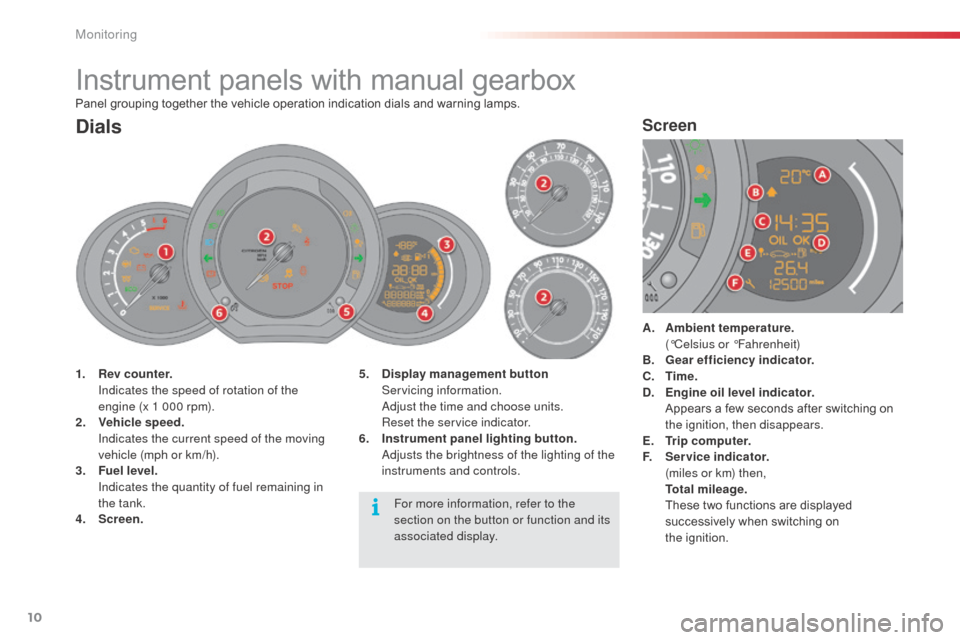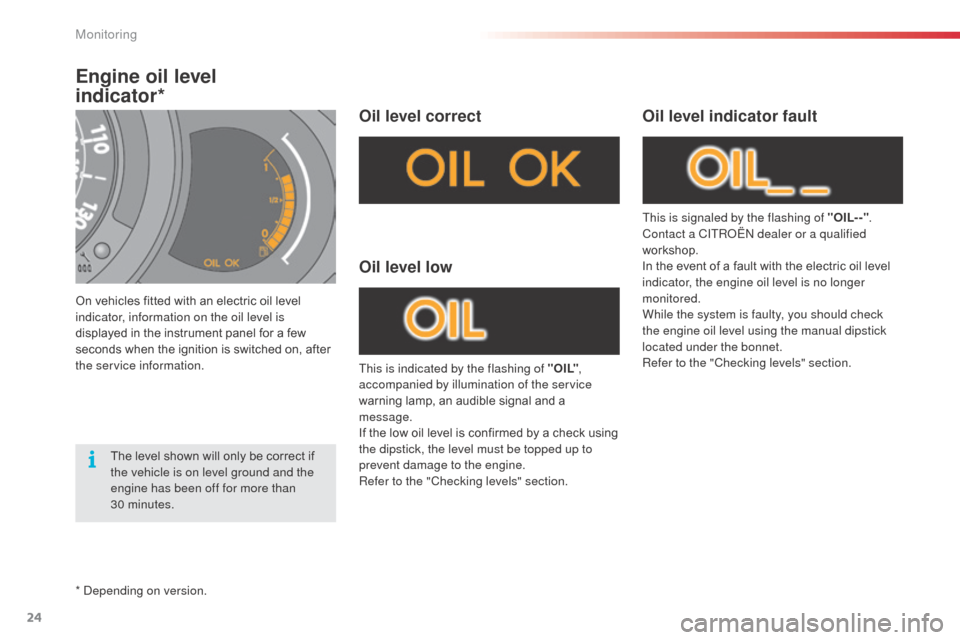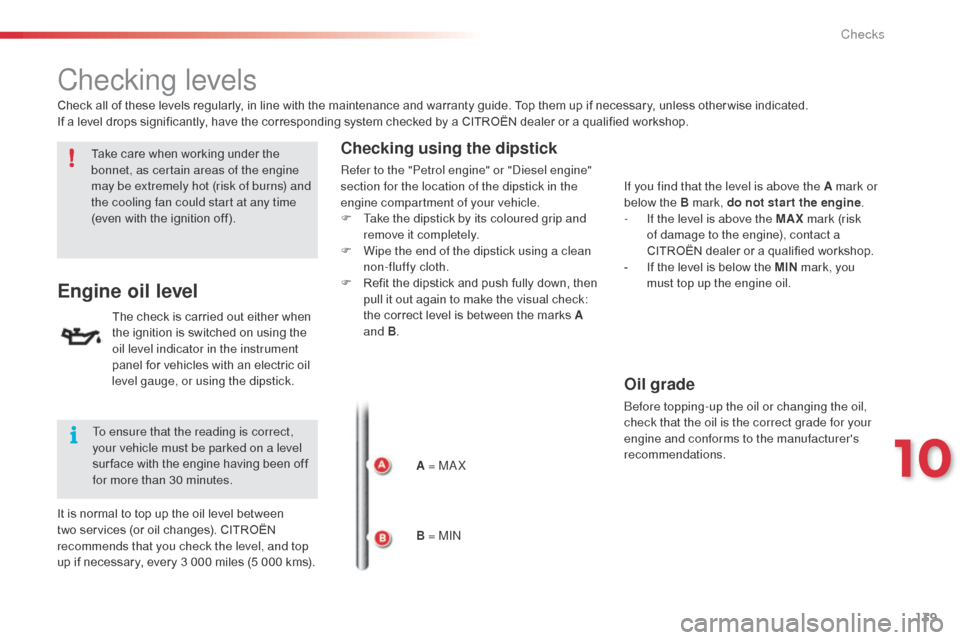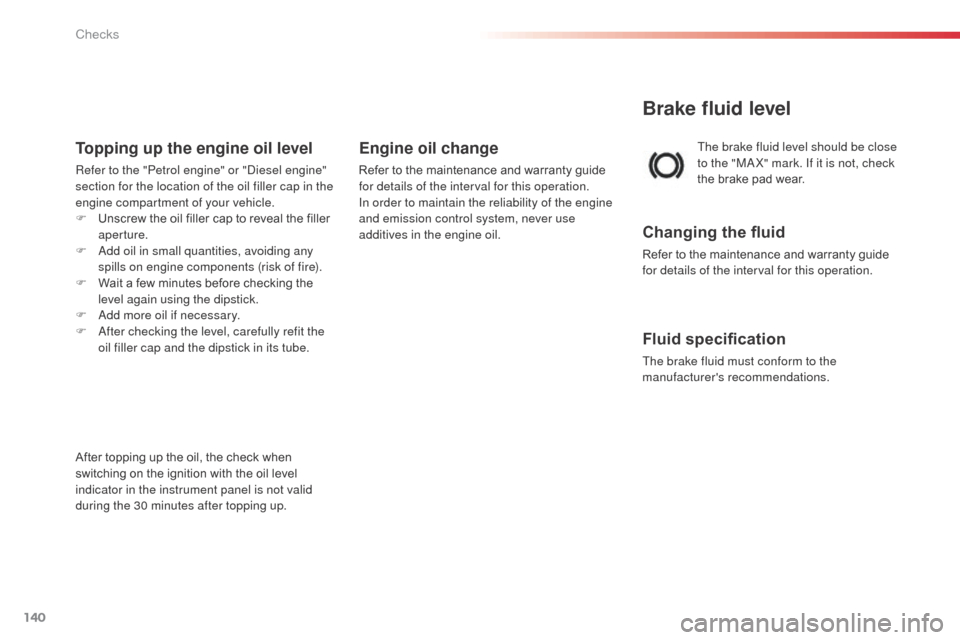oil level Citroen C3 RHD 2014 2.G Owner's Manual
[x] Cancel search | Manufacturer: CITROEN, Model Year: 2014, Model line: C3 RHD, Model: Citroen C3 RHD 2014 2.GPages: 284, PDF Size: 8.99 MB
Page 11 of 284

9
Limit the causes of excess consumption
Spread loads throughout the vehicle; place the heaviest items in the
bottom of the boot, as close as possible to the rear seats.
Limit the loads carried in the vehicle and reduce wind resistance (roof
bars, roof rack, bicycle carrier, trailer...). Use a roof box in preference.
Remove roof bars and roof racks after use.
At the end of winter, remove snow tyres and refit your summer tyres.
Observe the recommendations on maintenance
Check the tyre pressures regularly, when cold, referring to the label in
the door aperture, driver's side.
Carry out this check in particular:
-
b
efore a long journey,
-
a
t each change of season,
-
a
fter a long period out of use.
Don't forget the spare wheel and the tyres on any trailer or caravan.
Have your vehicle serviced regularly (engine oil, oil filter, air filter,
passenger compartment filter...) and observe the schedule of
operations recommended in the maintenance and warranty guide.
With a
b
l
ueH
di
d
i
esel engine, if the SCR system is faulty your vehicle
becomes polluting; go to a CITROËN dealer or a qualified workshop
without delay to have the emissions of nitrous oxides brought back to
the legal level.
When refuelling, do not continue after the third cut-off of the nozzle to
avoid any over flow.
At the wheel of your new vehicle, it is only after the first 1 800 miles
(3 000 kilometres) that you will see the fuel consumption settle down to
a consistent average.
Eco-driving
.
Page 12 of 284

10
Panel grouping together the vehicle operation indication dials and warning lamps.
Instrument panels with manual gearbox
5. Display management button S
ervicing information.
a
d
just the time and choose units.
R
eset the service indicator.
6.
I
nstrument panel lighting button.
a
d
justs the brightness of the lighting of the
instruments and controls.
1. R
ev counter.
I
ndicates the speed of rotation of the
engine (x 1 000 rpm).
2.
V
ehicle speed.
I
ndicates the current speed of the moving
vehicle (mph or km/h).
3.
F
uel level.
I
ndicates the quantity of fuel remaining in
the tank.
4.
S
creen. A.
A
mbient temperature.
(
°Celsius or °Fahrenheit)
B. G ear efficiency indicator.
C. Ti me.
D.
E
ngine oil level indicator.
A
ppears a few seconds after switching on
the ignition, then disappears.
E.
T
rip computer.
F.
S
ervice indicator.
(
miles or km) then,
T
otal mileage.
T
hese two functions are displayed
successively when switching on
the
ignition.
Screen
For more information, refer to the
section on the button or function and its
associated display.
Dials
Monitoring
Page 13 of 284

11
Instrument panels for electronic or automatic gearboxes
Panel grouping together the vehicle operation indication dials and warning lamps. Depending on the version, the instrument panel may have permanent
back-lighting.
1.
R
ev counter.
I
ndicates the speed of rotation of the
engine (x 1 000 rpm).
2.
V
ehicle speed.
I
ndicates the current speed of the moving
vehicle (mph or km/h).
3.
F
uel level.
I
ndicates the quantity of fuel remaining in
the tank.
4.
S
creen.
5.
D
isplay management button
A
lternates display between range and trip
mileage recorder.
S
ervicing information.
R
esets the selected function to zero (trip
distance recorder or service indicator).
6.
I
nstrument panel lighting button.
a
d
justs the brightness of the lighting of the
instruments and controls.
ScreenDials
For more information, refer to the
section on the button or function and its
associated display. A.
S
peed limiter
(
mph or km/h) or
C
ruise control.
B.
G
ear efficiency indicator.
C.
E
lectronic
or automatic gearbox
information.
D.
R
ange
(
miles or km) or
T
rip mileage recorder.
E.
S
ervice indicator
(
miles or km), then
T
otal mileage recorder
. T hese two functions are displayed
successively when switching on the ignition
F.
E
ngine oil level indicator.
A
ppears a few seconds after switching on
the ignition, then disappears.
1
Monitoring
Page 19 of 284

17
Any fault resulting in the illumination of a warning lamp must be investigated further by
reading the associated message in the multifunction screen.
If you encounter any problems, do not hesitate to contact a CITROËN dealer or a qualified workshop.
Warning lamps
When the engine is running or the vehicle is
being driven, the illumination of one of the
following warning lamps indicates a fault which
requires action on the part of the driver.STOP fixed, alone or
associated with
another warning lamp,
accompanied by an
audible signal and
a message on the
screen. Illumination of the warning lamp is
associated with a serious braking
system or engine coolant temperature
problem.
Stop as soon as it is safe to do so as the engine may
cut out when driving.
Park, switch off the ignition and call a CITROËN
dealer or a qualified workshop.
Service temporarily. Minor problems have occurred for
which there is no specific warning
lamp.
Identify the problem by reading the message shown in the
screen, such as, for example:
- the engine oil level,- the screenwash level,- the remote control battery,- saturation of the particle emission filter on di esel vehicles
(refer to the "Particle emissions filter (di esel)" section).
For any other faults, contact a CITR
oËn
dealer or a qualified
workshop.
fixed. Major problems have occurred for
which there is no specific warning
lamp. Identify the problem by reading the message shown
in the screen and contact a CITRoËn
dealer or a
qualified workshop.
Warning
/indicator lampis on Cause Action / Observations
1
Monitoring
Page 21 of 284

19
Maximum
coolant
temperaturefixed.
The temperature of the cooling
system is too high. Stop as soon as it is safe to do so.
Wait until the engine has cooled down before topping
up the level, if necessary.
If the problem persists, contact a CITR
oËn
dealer or
qualified workshop.
Engine oil
pressure fixed.
There is a fault with the engine
lubrication system. You must stop as soon it is safe to do so.
Park, switch off the ignition and contact a CITROËN
dealer or a qualified workshop.
Battery charge fixed. The battery charging circuit has a
fault (dirty or loose terminals, slack or
cut alternator belt, ...). The warning lamp should go off when the engine is
started.
If it does not go off, contact a CITR
oËn
dealer or a
qualified workshop.
Low fuel level
fixed. When it first comes on there remains
approximately 5 litres of fuel in the
tank. You must refuel as soon as possible to avoid running
out of fuel.
This warning lamp will come on every time the ignition
is switched on, until a sufficient addition of fuel is
made.
Fuel tank capacity: approximately 50 litres (petrol),
46 litres (Diesel) or 37 litres (LPG); depending on
version: approximately 30 litres (petrol or d
i
esel).
ne
ver continue to drive until you run out of fuel as
this could damage the emission control and injection
systems.
Warning
/indicator lampis on Cause Action / Observations
1
Monitoring
Page 26 of 284

24
Engine oil level
indicator*
On vehicles fitted with an electric oil level
indicator, information on the oil level is
displayed in the instrument panel for a few
seconds when the ignition is switched on, after
the service information.
Oil level correct
This is indicated by the flashing of " O I L",
accompanied by illumination of the service
warning lamp, an audible signal and a
message.
If the low oil level is confirmed by a check using
the dipstick, the level must be topped up to
prevent damage to the engine.
Refer to the "Checking levels" section.
Oil level low
This is signaled by the flashing of "OIL- -" .
Contact a CITRoËn dealer or a qualified
workshop.
In the event of a fault with the electric oil level
indicator, the engine oil level is no longer
monitored.
While the system is faulty, you should check
the engine oil level using the manual dipstick
located under the bonnet.
Refer to the "Checking levels" section.
Oil level indicator fault
The level shown will only be correct if
the vehicle is on level ground and the
engine has been off for more than
30 minutes.
*
d
ep
ending on version.
Monitoring
Page 141 of 284

139
Checking levels
Engine oil level
The check is carried out either when
the ignition is switched on using the
oil level indicator in the instrument
panel for vehicles with an electric oil
level gauge, or using the dipstick.
Checking using the dipstick
Refer to the "Petrol engine" or "di esel engine"
section for the location of the dipstick in the
engine compartment of your vehicle.
F
T
ake the dipstick by its coloured grip and
remove it completely.
F
W
ipe the end of the dipstick using a clean
non-fluffy cloth.
F
R
efit the dipstick and push fully down, then
pull it out again to make the visual check:
the correct level is between the marks A
and B .
To ensure that the reading is correct,
your vehicle must be parked on a level
sur face with the engine having been off
for more than 30 minutes.
Check all of these levels regularly, in line with the maintenance and warranty guide. Top them up if necessary, unless other wise indicated.
If a level drops significantly, have the corresponding system checked by a CITROËN dealer or a qualified workshop.
Take care when working under the
bonnet, as certain areas of the engine
may be extremely hot (risk of burns) and
the cooling fan could start at any time
(even with the ignition off).
It is normal to top up the oil level between
two services (or oil changes). CITROËN
recommends that you check the level, and top
up if necessary, every 3 000 miles (5 000 kms). A = M
aX
B
= MI
n
I
f you find that the level is above the A mark or
below the B mark, do not star t the engine .
-
I
f the level is above the MAX mark (risk
of damage to the engine), contact a
CITROËN dealer or a qualified workshop.
-
I
f the level is below the MIN mark, you
must top up the engine oil.
Oil grade
before topping-up the oil or changing the oil,
check that the oil is the correct grade for your
engine and conforms to the manufacturer's
recommendations.
10
Checks
Page 142 of 284

140
The brake fluid level should be close
to the "MaX" mark. If it is not, check
the brake pad wear.
Brake fluid level
Changing the fluid
Refer to the maintenance and warranty guide
for details of the interval for this operation.
Fluid specification
The brake fluid must conform to the
manufacturer's recommendations.
Topping up the engine oil level
Refer to the "Petrol engine" or "di esel engine"
section for the location of the oil filler cap in the
engine compartment of your vehicle.
F
U
nscrew the oil filler cap to reveal the filler
aperture.
F
a
d
d oil in small quantities, avoiding any
spills on engine components (risk of fire).
F
W
ait a few minutes before checking the
level again using the dipstick.
F
a
d
d more oil if necessary.
F
a
f
ter checking the level, carefully refit the
oil filler cap and the dipstick in its tube.
After topping up the oil, the check when
switching on the ignition with the oil level
indicator in the instrument panel is not valid
during the 30 minutes after topping up.
Engine oil change
Refer to the maintenance and warranty guide
for details of the interval for this operation.
In order to maintain the reliability of the engine
and emission control system, never use
additives in the engine oil.
Checks
Page 143 of 284

141
Additive level (Diesel with
particle emissions filter)
according to your version of instrument panel,
the additive reservoir low level is indicated by:
To p p i n g u p
The reservoir must be topped up without delay
by a CITROËN dealer or a qualified workshop.
Used products
- fixed illumination of the particle emissions filter warning lamp,
accompanied by an audible signal,
or
-
fixed illumination of the service
warning lamp, accompanied by
do not discard used oil or fluids into
sewers or onto the ground.
Take used oil to a CITR
oËn
dealer or
a qualified workshop (France) or to an
authorised waste disposal site.
av
oid prolonged contact of used oil or
fluids with the skin.
Most of these fluids are harmful to
health or indeed very corrosive.
Coolant level
The coolant level should be close
to the "MaX " mark but should never
exceed it.
When the engine is warm, the temperature of
the coolant is regulated by the fan.
Changing the coolant
The coolant does not have to be replaced at routine services.
Fluid specification
The coolant must conform to the
manufacturer's recommendations. Top up the level when necessary.
The cooling fan may star t after
switching off the engine: take care
with articles and clothing that might
be caught by the fan blades.
In addition, as the cooling system is pressurised,
wait at least one hour after switching off the
engine before carrying out any work.
To avoid any risk of scalding, unscrew the cap
by two turns to allow the pressure to drop. When
the pressure has dropped, remove the cap and
top up the level.
Screenwash fluid level
Fluid specification
For optimum cleaning and to avoid freezing,
this fluid must not be topped up or replaced
with plain water.
In wintry conditions, it is recommended that you
use an ethyl alcohol or methanol based fluid.
an
audible signal and a message that the
particle emissions filter additive level is too low.
10
Checks
Page 144 of 284

142
according to your version of instrument panel, the start of
saturation of the particle emissions filter is indicated by:
- fixed illumination of the particle emissions filter warning lamp,
accompanied by an audible signal,
or
-
t
emporary illumination of
the
service warning lamp,
as s
oon as the traffic conditions permit,
regenerate the filter by driving at a speed of at
least 40
mph (60 km/h) until the warning lamp
goes off.
If the warning lamp stays on, refer to the
"
ad
ditive level" section.
Checks
12 V battery
The battery does not require any maintenance.
However, check that the terminals are clean
and correctly tightened, particularly in summer
and winter.
The presence of this label, in particular with
the Stop & Start system, indicates the use of
a specific 12 V lead-acid battery with special
technology and specification. The involvement
of a CITROËN dealer or a qualified workshop
is essential when replacing or disconnecting
the battery. When carrying out work on the battery, refer
to the "12 V battery" section for details of the
precautions to be taken before disconnecting
the battery and following its reconnection. Unless other wise indicated, check these components in accordance with the maintenance and warranty guide and according to your engine.
Other wise, have them checked by a CITROËN dealer or a qualified workshop.
On a new vehicle, the first operations of
regeneration of the particle emissions
filter may be accompanied by the smell
of "burning", which is per fectly normal.
Following prolonged operation of the
vehicle at very low speed or at idle,
you may, in exceptional circumstances,
notice the emission of water vapour at
the exhaust on acceleration. This does
not affect the behaviour of the vehicle
or the environment.
Particle emission filter (Diesel)
accompanied by an audible signal and a
message that there is a risk of blockage of the
particle emissions filter.
Air filter and passenger compartment filter
Refer to the maintenance and
warranty guide for details of the
replacement intervals for these
components.
depending on the environment (e.g. dusty
atmosphere) and the use of the vehicle (e.g. city
driving), replace them twice as often if necessar y .
a c
logged passenger compartment filter may have
an adverse effect on the per formance of the air
conditioning system and generate undesirable
odours.
Replace the oil filter each time the
engine oil is changed.
Refer to the maintenance and
warranty guide for details of the
replacement interval for this
component.
Oil filter
Checks